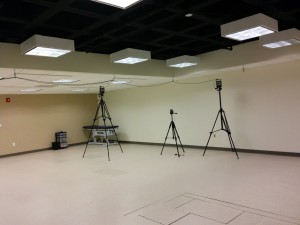The College of Nursing and Health Professions at Drexel University has recently opened the Gait Lab, which studies human movement and locomotion through the use of force plates and cameras.
Although researchers at Drexel have been involved in rehabilitation science and physical therapy for a long time, the Gait Lab is a new feature. Researchers at the lab, including Clare Milner, an associate professor in rehabilitation science, are making advances in biomechanical research. Milner uses the Gait Lab to focus on lower extremity injuries, injury prevention and rehabilitation.

“We’re in the final stages of setting up the Gait Lab right now. When I got here last year in July, this was just an empty room. Since then, we’ve been able to add the research equipment we use in here,” Milner said.
Biomechanics is the study of movement in the human body. The area of biomechanics has been around for almost 30 years, but the technology used at the Gait Lab is a new advancement in the field. The technology used is similar to the tools used to create some video games and movies.
The research process requires participants to wear markers, small silver balls that are 12 millimeters by a half of an inch and six millimeters by a quarter of an inch. Force plates are placed in the middle of the lab and used to measure the level of impact when the participants walk or run on top of them. The technology measures the joint angles to one-tenth of a degree at 240 times per second. This raw data is then processed to put together the entire body’s motion on a screen.
Milner and the researchers at the lab look at various test subjects, such as runners and older adults.
“We’re looking at the physics of the human body. … Young athletes are at risk of injuries and older adults are at risk of joint damage. If we can figure out the movement patterns that are problematic, maybe we can modify those,” Milner said.
For example, researchers use the technology to study how the knee flexes and extends in addition to the resultant forces and angles at the joints, which could help them understand the types of overuse injuries that runners are prone to.
“We’ll look at runners who run to stay healthy and runners who run the same amount but get injured. We try and identify some of these differences through movement patterns,” Milner explained.
Milner also studies the landing position of female basketball and volleyball athletes. With the help of the technology at the Gait Lab, researchers can look into intervention programs that may help change the way athletes land, and therefore prevent injuries.
“[Women] are at an increased risk of knee injury like [anterior cruciate ligament] tears, more than men. There is a lot of interest in the biomechanics field in understanding if body position is related to that,” she said.
Milner has been involved in rehabilitation science since the late ‘90s after completing her doctorate in England. Before beginning her research at Drexel University, she was a faculty member at the University of Tennessee. During her time there, she studied recreational activities that challenge the knee.
“It’s something I’m planning to continue to explore and investigate now that I’m here,” she added.
In the next academic year, Milner will be looking for undergraduate students interested in learning about human movement research to assist in the lab.

